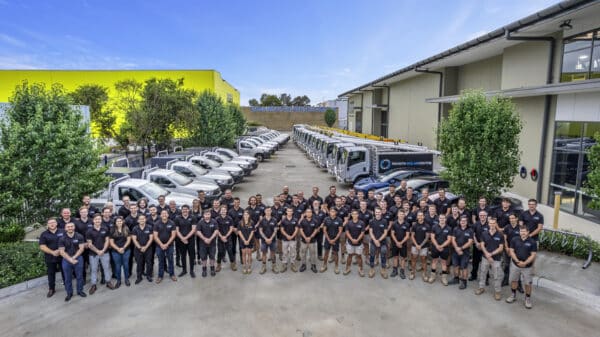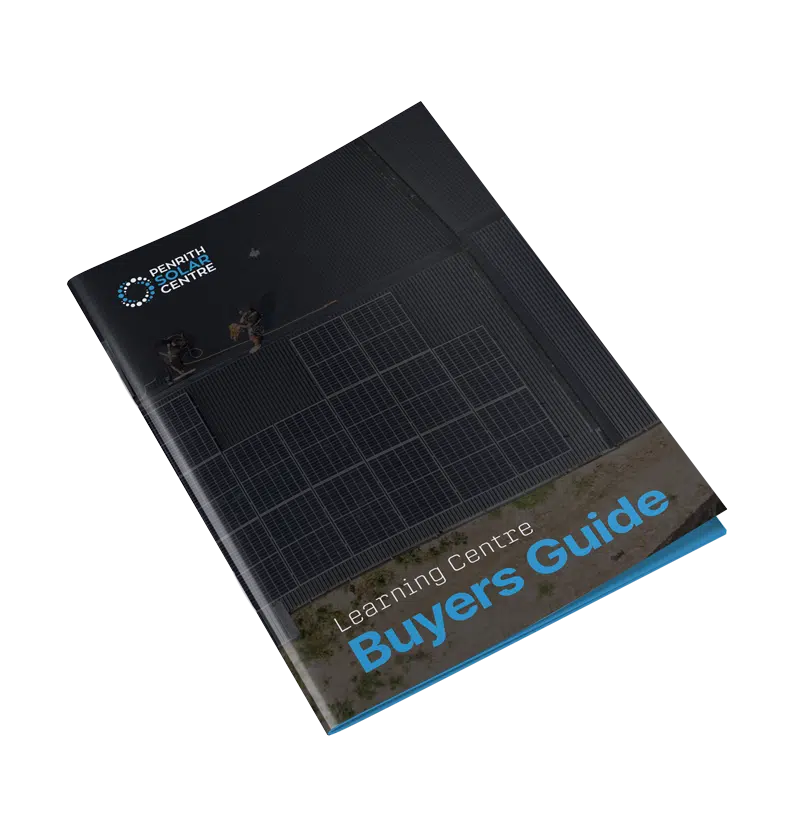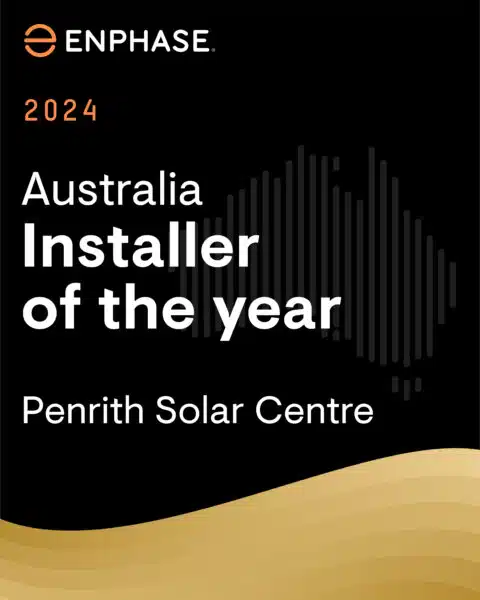
Choosing the right solar system is can be confusing at times. With all the noise about different inverters and batteries, it’s easy to get lost.
The Powerwall 3 is the latest innovation in solar technology that combines a powerful battery, solar input, and a hybrid inverter all in one unit.
This isn’t just another piece of tech; it’s a game-changer for the solar industry.
At Penrith Solar Centre, we understand how complicated shopping for quotes can be. We’re here to tell you about Powerwall 3 systems because it’s not just another solar product; it offers something more.
In this article, you will learn about:
- What Are the Specs and Features of Tesla Powerwall 3?
- What Are the Safety Considerations for Powerwall 3?
- Payback Periods and the Powerwall 3
- Beyond Financial Payback: Other Benefits of the Powerwall 3
- The Bottom Line: Why Powerwall 3 Offers Great Value
By the end of this article, you’ll understand what the Powerwall 3 offers and whether or not it’s worth the upfront cost.
What Are the Specs and Features of Tesla Powerwall 3?
The Tesla Powerwall 3 is a new solar system disguised as a battery. It’s a battery/hybrid inverter combination that can be installed as an AC or DC-coupled battery and system.
AC or DC coupling is just how the unit is wired to the home and solar system.
When installed as a new system with DC coupling, it can input up to 20kW of solar panels. When installed as an AC-coupled battery, it becomes brand-agnostic and can be added to any solar system.
Let’s look at the specs.
Specifications
- Capacity: The unit offers a storage capacity of 13.5 kWh.
- Scalability: Expandable up to four units for a capacity of 54kWh for now, but in the first quarter of 2025 it will be expandable up to 216kWh with battery units that don’t have an inverter enclosed.
- Power Output: 11.04 kW continuous power output. Unfortunately, it must be programmed for a maximum output of 10kW due to DNSP grid limits for inverters in New South Wales.
- Operating Temperature: -20°C to 50°, indoor and outdoor rated.
- Dimensions: 1099 mm x 609 mm x 193 mm.
- Weight: 130kg
- Mounting: Floor or wall mounting.
Integrated Hybrid Inverter: One of the newest features in the Powerwall 3 is the built-in hybrid inverter. Powerwall 3 does the work of both components, inverter and battery. It can convert the energy stored in the battery into electricity that your home can use.
Safety: Tesla has opted for lithium iron phosphate (LFP) cells for the Powerwall 3. These cells are known for their stability and safety.
Flood-resistant Design: Tesla has designed the Powerwall 3 to withstand tough conditions. It can be submerged in water up to 600 millimetres, making it more resilient in areas prone to extreme weather with the possibility of a little flooding.

Solar Input: The Powerwall 3 supports up to 20kW of solar, which is a lot of panels. The solar input actually bypasses the inverter when it’s charging from the solar on the roof creating greater charging efficiencies.
Multiple Trackers: The Powerwall 3 includes three Maximum Power Point Trackers (MPPTs). When panels experience things like shading or different orientations, the MPPTs adjust and optimise the power output to achieve the best possible performance across three solar panel arrays. Each MPPT is responsible for one of three solar arrays. When one array drops in efficiency due to shading or some other obstruction, the other two won’t be affected.
Installation: Penrith Solar Centre can get your Powerwall 3 up and running fast, often in just one day depending on how much solar you’re installing with it. That means lower labour costs, which means a shorter payback period, and quicker energy savings in your pocket. Of course, all of that depends on the conditions of the site.
A solar consultant can walk you through installation considerations better than this article. However, if you are interested in reading an article about this, we recommend starting with this one titled, How Does Your Roof Affect Your Installation?
Tesla App
The Tesla App adds another layer of value. The app is the control centre for your Powerwall 3 system. You can see how much power you’re generating, how much you’re storing, and when you’re pulling from the grid – all in real-time.
This software is slick, intuitive, and built with the user in mind. It puts you in control of your energy.
How the App Saves You Money:
- Track Your Energy Use: You can see exactly when your solar panels are generating the most power and plan your high-energy activities, like running appliances, during those times. This means pulling less from the grid and more savings.
- Make Energy Decisions: You’ll know when your battery’s full, when it’s discharging, and how much power you’re actually consuming. This helps you make smart choices about when to store energy and when to use it. Instead of guessing, you’ll know. The app lets you adjust your power usage instantly, giving you the flexibility to cut down on costs based on real-time data.
This system is built for everyday people who want a smart, powerful solar setup without the fuss. Imagine being able to handle your home’s energy from your phone – quick, simple, and without needing a manual to figure it all out.
That’s the kind of seamless experience Powerwall 3 offers.
If you’re curious about how the Powerwall 3 stacks up against its predecessor, you might want to check out the following article titled, What’s the Difference Between Powerwall 2 and 3?
What Are the Safety Considerations for Powerwall 3?
Safety is always a hot topic when it comes to solar, and there’s no skirting around it – DC power is scary for some folks. It’s a higher voltage than AC power. That’s one of the big reasons Enphase has been so popular. It outputs AC power to the home from the system and is safer.
Powerwall 3 has DC power travelling from the solar panels to the Powerwall. Those DC cables come straight down your walls, and it’s important for people to understand that if anything happens to that conduit and cabling, it could start a fire. Of course, the likelihood of that happening is slim, but in the interest of transparency, it needs to be mentioned.
All of that considered, Powerwall 3 has been designed with safety measures to help mitigate this risk.
- Built-In Safety Features: Tesla integrated safety checks and thermal controls to keep everything running smoothly. It’s built to handle the high voltage without putting your home at risk. There’s even arc fault detection. It shuts down the hybrid inverter the second it detects and arc between the panels and the inverter. This is usually caused by a wiring fault. It’s not foolproof, but it’s a good start.
If you’re interested in learning a bit more about the rapid shutdown feature in a solar system, you might want to check out the following article titled, How Important is Rapid Shutdown in a High Voltage DC Solar System?
Payback Periods and the Powerwall 3
If you’re thinking about adding a Tesla Powerwall 3 to your home, you’re probably wondering how long it will take to pay for itself. The payback period is the amount of time it takes to recover the money you plan to spend.
Understanding this can help you decide if the Powerwall 3 is a good investment for your home.
What is the Payback Period for the Tesla Powerwall 3?
The payback period for the Powerwall 3 when combined with solar can be as low as 5 years. This is unheard of when combining solar with a battery.
Of course, the payback period depends on several factors like how much electricity your home uses, how high your electricity bills are, and how much sunlight your solar panels can capture.
For example, if you live in New South Wales where electricity costs $0.38 per kilowatt hour on average, your Powerwall 3 could save you a lot of money over time. The more solar energy you can store and use, the less electricity you’ll need to buy from the grid.
- Reducing Peak-Time Usage: Electricity is more expensive during peak times, like evenings when people use more power. The Powerwall 3 lets you avoid buying electricity during these high-cost hours by using stored solar energy instead.
The higher the electricity rates, the faster you’ll see a return on your investment.
Energy retailers raised prices twice last year. Do you trust them to keep the prices stable or do you think they’ll raise them again?
Please Note: If you have solar panels already and are thinking about adding the Powerwall 3 to your system, your payback period will be longer. This is because the Powerwall 3 is an extra cost on top of your current system. The above payback period is for a DC-coupled installation of solar panels with Powerwall 3.
If you’re interested in learning a bit more about solar batteries, you might want to start with the following article titled, Adding a Battery to a Solar System.
Click here for solar solutions.
Beyond Financial Payback: Other Benefits of the Powerwall 3
While the payback period is important, there are other benefits to consider when thinking about Powerwall 3.
Backup Power During Outages: One of the biggest advantages of the Powerwall 3 is its ability to provide backup power. If there’s a power outage, the Powerwall 3 can keep your home running. This is especially helpful if you live in an area that experiences frequent outages.
Environmental Impact: By using the Powerwall 3, you’re helping to reduce your carbon footprint. You’re using renewable energy from the sun instead of electricity from non-renewable sources like coal or gas. This contributes to a cleaner, more sustainable environment.
If you’re interested in learning a bit more about the benefits of solar batteries, you might want to start with the following article titled, 7 Benefits of Adding a Battery to Your Solar System.
The Bottom Line: Why Powerwall 3 Offers Great Value
Powerwall 3 Redefines Solar:
- It’s not just a battery, it’s an entire solar system.
- Combines solar, storage, and smart management into one powerful unit.
Lower Upfront Costs:
- Saves on parts, labour, and delivers an integrated, efficient product.
Installation:
- Straightforward installation process that installers appreciate.
- Less disruption, lower costs, and less hassle for homeowners.
- This product was designed for installers and homeowners with Tesla’s mission in mind: accelerating the world to a sustainable energy source as quick as possible.
Tesla App:
- Allows you to monitor when panels generate the most power, helping you plan high-energy activities.
- Shows how much energy is stored, guiding decisions on when to use battery power instead of grid power.
- Adjust energy usage in real-time to optimise savings.
Built to Last, Even If It’s Not “Forever”:
- Delivers 10 to 15 years of reliable performance – enough to recoup your investment and save a lot of money.
Long-Term Performance:
- LFP chemistry ensures slower degradation and consistent power output.
- Designed to handle your home’s energy needs for years.
Changing the Solar Game:
- Makes solar more accessible, affordable, and easy to manage.
- Helps tackle rising energy costs, lowers carbon footprints, and reduces dependence on the grid.
Taking Control of Your Energy:
- More than just saving a few bucks—it’s about growing your own electrons. Powerwall 3 makes the most out of every watt harvested and dollar invested.
If you’re interested in learning a bit more about the upcoming solar battery rebate, you might want to check out the following article titled, Everything You Need to Know About the Home Battery Rebate for NSW.
Powerwall 3 Value: Is It Worth It?
Now you know a bit more about what to consider when pricing a Powerwall 3 and whether to install it. We looked at specs and features, safety considerations, payback periods, and additional benefits of owning a solar battery.
At Penrith Solar Centre, we know a thing or two about Powerwalls; we’ve been installing them since the first model came out years ago. We understand how much information there is out there and how important this choice is. We’re here to educate and guide you through this process.

If you’d like to learn more about Tesla products, we recommend you check out the following article titled, Tesla Powerwall 3 Review: An In-Depth Look at Tesla’s New Solar Battery.










